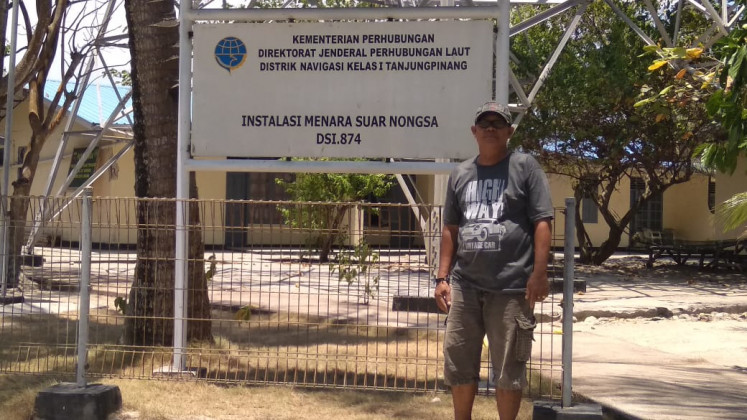Popular Reads
Top Results
Can't find what you're looking for?
View all search resultsPopular Reads
Top Results
Can't find what you're looking for?
View all search results'Solitude is my true friend': Lighthouse keeper shares stories
Lighthouse keeper Heriyanto has shared his stories of working in the field for 33 years.
Change text size
Gift Premium Articles
to Anyone
H
aving been a lighthouse keeper on some of Indonesia’s most remote islands for the last 33 years, solitude is no stranger to Heriyanto.
“Solitude is my true friend,” the 57-year-old man told The Jakarta Post at his current assignment location on Putri Island in Nongsa district, Batam, over the weekend.
Putri Island is one of the country’s outermost islands, directly facing Malaysia and Singapore. Its lighthouse was built in 1996 by the Transportation Ministry.
Following in his father's footsteps, Heriyanto began his career as a lighthouse keeper on Mangkai Island in Natuna, Riau Islands, in 1986 with a junior high school diploma. He is now the lighthouse’s head and will retire in September.
Mangkai Island, which faces the South China Sea, was previously uninhabited. Its lighthouse is located on top of a hill that is so high that, the first time Heriyanto tried to reach his post, he had to take three breaks before arriving at the top. His first task was to tend to the lighthouse’s lighting tools and the tower itself.
“It remains the most memorable place for me, as it was my first assignment that led to numerous experiences, including the first time I met a ghost,” he said. “But fear had no use there. I had to endure everything.”
Lighthouse keeper Heriyanto stands in front of his post on Putri Island. (JP/Fadli)In total, Heriyanto has lived on 24 remote islands as a lighthouse keeper. His first salary was Rp 25,000 (US$1.75) per month. Now, he receives Rp 3 million plus an additional Rp 4 million performance allowance.
“All goes directly to my wife and kids,” he said, adding that he and his family lived separately as it would be difficult for him to raise a family and send his children to schools on remote islands.
Heriyanto’s three daughters live in Tanjungpinang, Riau, with his wife. He goes home every three months, taking turns manning the lighthouse with his colleagues.
A lighthouse usually had three to five officers, he said, but the number had decreased over time.
“Now, there are only the two of us here. Not that many people wish to work in a lighthouse,” he said.
Perhaps they have gotten used to the solitude, or perhaps it is in their nature to work in an isolated place where interactions are kept to a minimum. Heriyanto said that, on uninhabited islands, the keepers would stay in separate large houses assigned to them, often equipped with farming fields to keep them occupied during leisure time.
After all, he said, “Our main job is to make sure the lighthouse works accordingly.”
All lighthouse keepers are also required to be able to recognize any kind of flag or light signaled by a ship. As such, the top deck of the lighthouse tower is off limits to all visitors for security reasons.
Lights of the Putri Island lighthouse are on from 6 p.m. to 6 a.m. every day. The lights emitting from the tower are unique, acting as a distinct code for the island and informing ships where they are.
“Every ship is equipped with lighthouse codes, so when they see one, they know where they’re at,” Heriyanto said.
Along with the improving technology, diesel fuel had been replaced by solar cells to power the light in the tower. The lighthouse can also guide any nearby ship to its rightful course.
“It can signal in three languages – Indonesian, Japanese and English – to ships that are off course,” Heriyanto said.
Read also: 2,000 foreign cruise passengers arrive in Bintan, Riau
A lighthouse keeper’s life
A solitary life is something Heriyanto is accustomed to. He remembered that the farthest place he ever worked at was on Saint Petrus Island on the border of Kalimantan. It would take him 22 hours by boat to reach the island.
“The lighthouse was built in the Dutch [colonial] era and is located in the middle of nowhere. There was only silence everywhere I went, and that’s something I had to enjoy,” he said.
According to Heriyanto, falling ill was a problem as most lighthouse keepers tended to rely on traditional medicines. “Rescue ships usually came after three days,” he said.
To kill time, keepers make friends with amateur radio operators using communication radios. “There is no cellphone signal in the area, so we turn to radios,” he said.
Though they are located far from everywhere, lighthouse keepers are able to cast votes during elections with the help of local poll administrators (KPPS) who make trips to remote islands by boat.
“The only time I didn’t vote was when I was working on Saint Petrus Island, because it was a 22-hour trip there,” he recalled.
Nearing his retirement, Heriyanto said he hoped for a salary increase for lighthouse keepers, if not for this generation then for the next.
“We face enormous challenges every day,” he said. (swa/wng)












